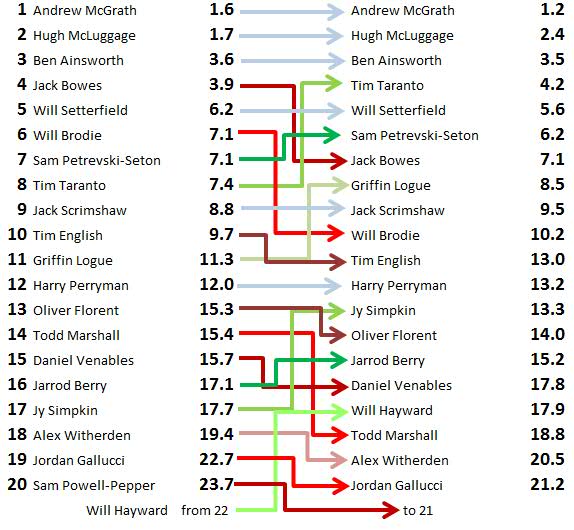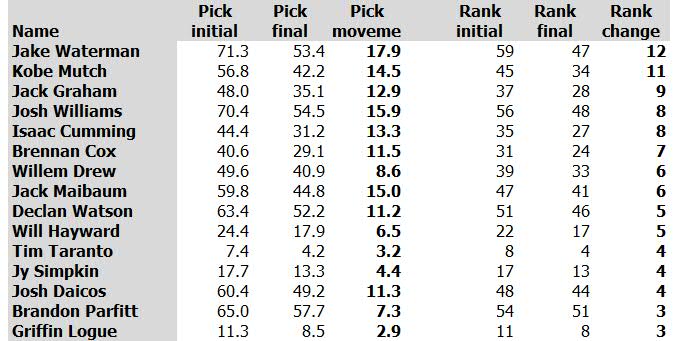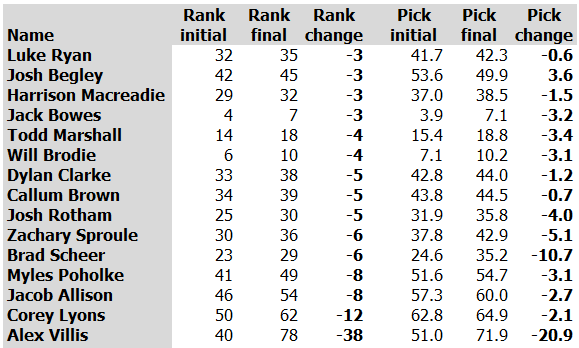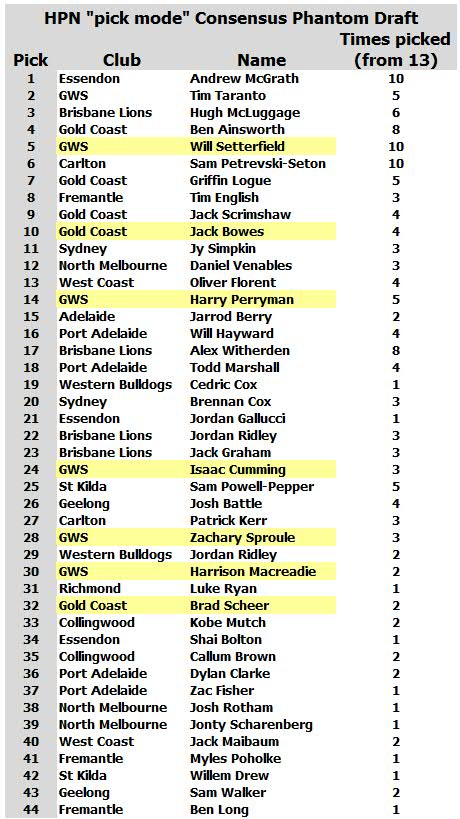AFL Draft Day is upon us, and it appears that the draft picture is finally clearing up. As a quick refresher, the HPN Consensus Phantom Draft (CPD) takes a bunch of phantom drafts from different sources, combines the rankings and sorts the players accordingly. HPN also looks at the “mode” selections, I.E. which clubs are linked to what players, and at what pick. This post describes it in more detail.
The drafts used are:
- Matt Balmer at AFL Draft Central
- Josh Poulter at Bigfooty and elsewhere
- Chris Doerre/Knightmare at ESPN
- Footy Prophet’s collective phantom draft
- AFL Draft Central’s collective phantom draft
- Katfish at The Roar
- DraftMe at Bigfooty
- Cal Twomey at afl.com.au
- Riley Beveridge at FoxSports
- The r/AFL (Reddit) collective phantom draft
- Tom Baulch at The Roar
- Brett Anderson at SEN
- Emma Quayle at Fairfax
But with no further ado:

NOTE: Jack Bowes will almost certainly not be selected at pick 6 because that pick is already the Suns’ (but he will be matched by GC wherever he is bid on). Before we discuss the CPD in more depth, let’s have a look at how the first round has shifted in the last week and a bit.

At the top end of the CPD the three players have firmed up, but HPN considers that the top three being selected in this order to be very unlikely. Tim Taranto has risen sharply in the final few days, with GWS’s rumoured interest pushing him up the order. In response, Jack Bowes has a nearly identical slide down the order, perhaps fuelled by the suggestion that Brisbane will not bid on him at 3. Will Brodie also slides significantly down the pecking order, dropping down to the fringes of the top 10. WA youngster Griffin Logue also jumps into the top 10, at the expense of Tim English. Elsewhere, Jy Simpkin and Will Hayward’s stocks have improved in the last few days of doing nothing, with Todd Marshall going the other way to balance it out somewhat.
Risers and Sliders
Here’s a list of all the players that have either risen or fallen at least three draft spots since the last CPD:

Jake Waterman is the biggest riser over the last 11 days, with his stocks improving from being a fringe pick to a firm choice at the start of the 3rd round. Kobe Mutch has also been the focus of much speculation, notably around whether GWS will match his bid or not – consensus is he’ll be let slip by the Giants.
But perhaps the biggest rise (with respect to draft implications) is that of Isaac Cumming, who has firmly moved to a mid second round selection to the fringes of the first. We believe that the CPD may have him a touch low at pick 27, considering he was a last minute addition to the attendance list at the Draft (something usually reserved for first rounders and potential top-10 picks).
Emma Quayle is indicative of this change, with the Age scribe suggesting that Sydney will bid on Cumming at pick 10 – worlds away from his original place in the pecking order. If Cumming was to go that early, there may be major complications around the availability of other GWS academy selections.

The biggest slider of the draft is, unfortunately, Alex Villis, who is unlikely to be selected on the night after a heart issue was picked up by a medical screening before the draft. Two academy selections, Zach Sproule and Brad Scheer, have seemingly slid down the order, perhaps a byproduct of the increased attention on Cumming and Mutch. Other notable sliders include Josh Rotham, Dylan Clarke and Corey Lyons, the latter of which has nearly slid out of contention for being selected.
Why the CPD above might not happen, and a potential better method
The critical issue of the CPD at the top of the post is that it unlikely to cover the scenarios presented by the draft. Last year’s champion Matt Balmer laid it out simply on twitter earlier this week:
Just over 56 hours until Pick 1 is called out. At this stage, 3 different likely scenarios with the top 6. #AFLDraft Scenario 1 my tip ✔️ pic.twitter.com/f8chno36Q9
— Matt Balmer (@MattBalmer7) November 22, 2016
Balmer is not alone with selecting scenario 1 as the most likely; of the later and more reputable phantom drafts (such as those by Quayle, Twomey and Anderson) have all opted for scenario 1. The issue with this is that not all the phantom drafts agree with this as the most likely scenario. All of our drafters agree that McGrath will go in the top two – beyond that confusion reigns. As a result three of our thirteen phantoms still have McCluggage going at pick 1, and some have him snapped up at 2. And whilst opinion is moving to Taranto being subsequently chosen at 2, it is far from unanimous at this point.
To try to account for this, HPN has revived a secondary method that we deployed last year to look at the most likely consequential outcomes of each pick. The Mode CPD looks at the most common selections at each pick, after the players that have previously been chosen have been removed from the pool.

Essentially, for the top 20 or 25 picks, this represents the most favoured “decision tree” among those available to clubs. Beyond this point, and due to the sheer amount of talent on offer, the consensus fades significantly. It should be noted that any ties later on are broken by the higher average selection as determined by the method above.
HPN will be back next week with a draft recap, and to look at which phantom drafter was the most accurate.
